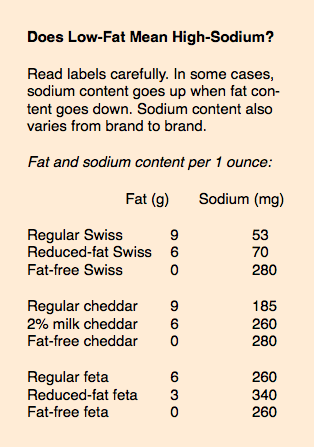Cheese: What You Need to Know
Lots of us have a love/hate relationship with cheese. We love how it goes with a good glass of wine or tops a pizza. We don’t care so much for its saturated fat, cholesterol, and sodium content. The good news is that cheese can be part of a healthy diet. Here are a few things to consider: 1. Cheese, a good source of protein and calcium, is a dairy food. Adults need three servings daily from this food group and most don’t meet this goal.2. Most cheese contains more sodium and saturated fat, yet less potassium, vitamin A, and vitamin D than milk or yogurt. For this reason, the Dietary Guidelines for Americans recommends that you choose milk and yogurt more often than cheese. However, some research suggests that cheese (and other dairy products) is not the culprit when it comes to heart disease, diabetes, & obesity.3. Some cheeses are naturally lower in fat than others. Fresh mozzarella, soft goat cheese, and string cheese have the same amount of fat as reduced-fat versions of cheddar, Swiss, and provolone.4. Some cheeses are naturally lower in sodium than others. Swiss cheese and fresh mozzarella have less than 100mg of sodium per ounce. Low-sodium versions of cheese can contain just a few milligrams per serving.5. Using visuals can help you stick to the right serving size. For example, 1.5 ounces of cheese is about the size of a 9-volt battery. One ounce of cheese is like a small matchbox or your thumb.6. Get the taste you love with less fat and sodium by using a smaller amount of more flavorful cheese. A little freshly grated Parmesan goes a long way on a salad. A thin slice of extra sharp cheddar does the same for a sandwich or burger.7. Skip the processed cheese. One ounce of American cheese has more than 450mg of sodium! And the plastic-y taste can’t compare to the real thing.By Hollis Bass, MEd, RD, LD
1. Cheese, a good source of protein and calcium, is a dairy food. Adults need three servings daily from this food group and most don’t meet this goal.2. Most cheese contains more sodium and saturated fat, yet less potassium, vitamin A, and vitamin D than milk or yogurt. For this reason, the Dietary Guidelines for Americans recommends that you choose milk and yogurt more often than cheese. However, some research suggests that cheese (and other dairy products) is not the culprit when it comes to heart disease, diabetes, & obesity.3. Some cheeses are naturally lower in fat than others. Fresh mozzarella, soft goat cheese, and string cheese have the same amount of fat as reduced-fat versions of cheddar, Swiss, and provolone.4. Some cheeses are naturally lower in sodium than others. Swiss cheese and fresh mozzarella have less than 100mg of sodium per ounce. Low-sodium versions of cheese can contain just a few milligrams per serving.5. Using visuals can help you stick to the right serving size. For example, 1.5 ounces of cheese is about the size of a 9-volt battery. One ounce of cheese is like a small matchbox or your thumb.6. Get the taste you love with less fat and sodium by using a smaller amount of more flavorful cheese. A little freshly grated Parmesan goes a long way on a salad. A thin slice of extra sharp cheddar does the same for a sandwich or burger.7. Skip the processed cheese. One ounce of American cheese has more than 450mg of sodium! And the plastic-y taste can’t compare to the real thing.By Hollis Bass, MEd, RD, LD
